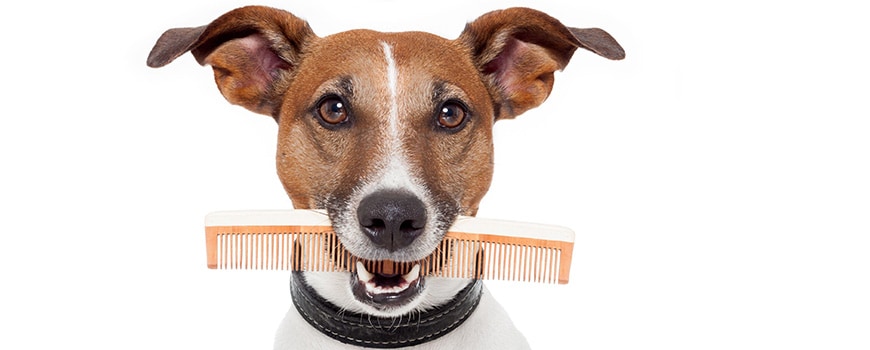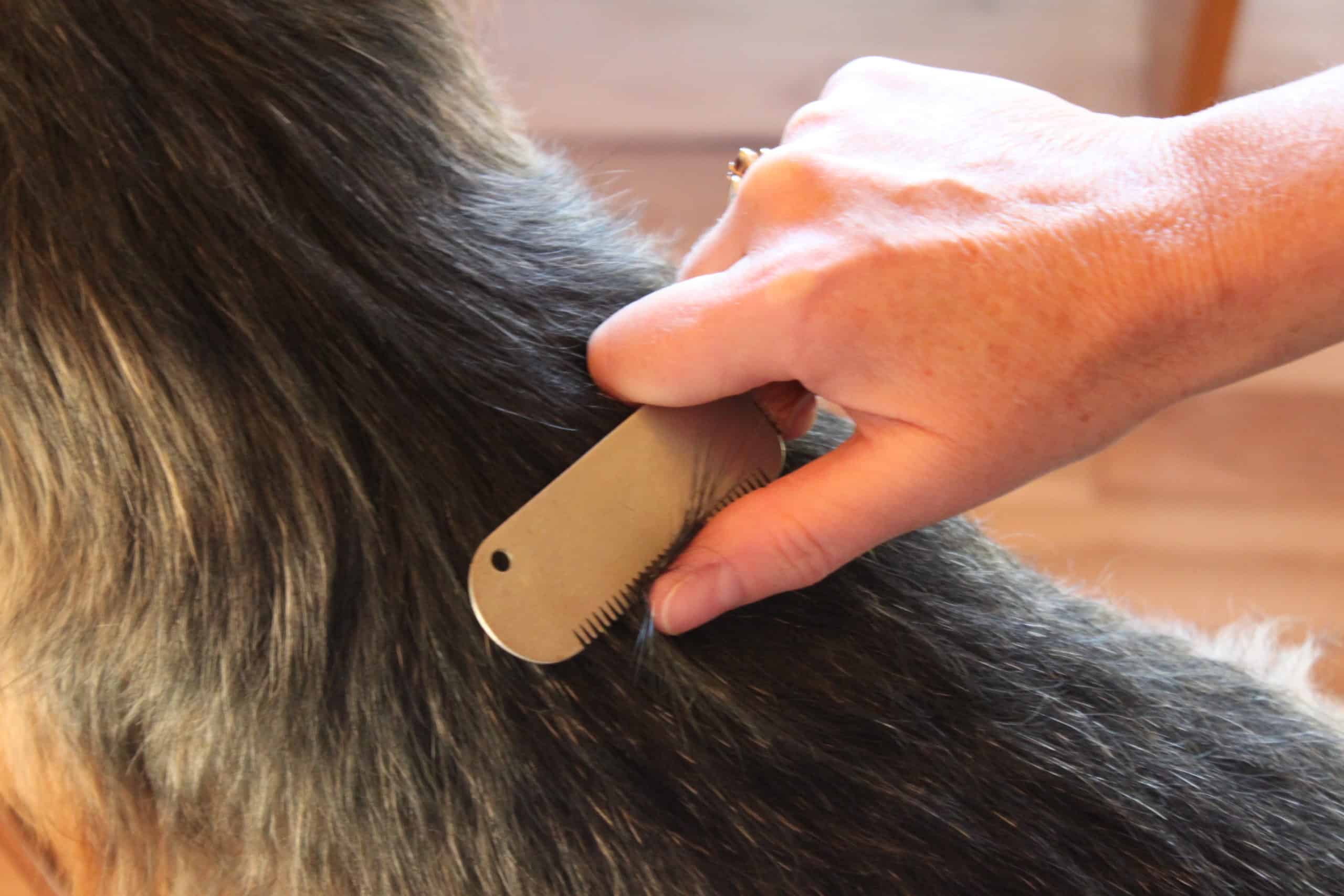Carding refers to a method of styling the coat by removing the undercoat with the aid of a stripping knife, a fine-toothed blade or a tool such as a Furminator . The idea is that the undercoat is either thinned out or removed, and it is in effect an alternative method of grooming out a dead undercoat by hand plucking.
In principle, carding does have some merits:
- It is easier on the hands and fingers than hand plucking
- You do not need to know how to hand pluck in order to do the job
- The end result can be achieved over several groomings rather than all in one go
- It can help to restore a clipped silk coat to a silky texture.
As long as the job is done well, the coat should remain easy to manage and aesthetically pleasing to look at. lf it has not been undertaken correctly, however, the effect is quite the opposite. The main reason for this is that the tools used to drag the dead undercoat out from the topcoat are sharp and will cut the coat if used incorrectly. If you are going to cut the coat, you may as well save yourself a lot of effort and use clippers!
If you do choose to remove the undercoat by this method, before you start take a close look at the tool you will be using. Both the stripping knife and the Furminator, resemble a comb blade from a very fine clipper blade. They are formed of short metal teeth and the junction between the teeth is sharp, and it is this sharp metal at the junctions that will cut any hairs crossing its path.
If the tool is in an upright position, the hairs will be dragged between the teeth and they will either be cut clean across their shafts at some point or, worse still, there will be many lacerations along the length of the shaft, causing weakening of the hair structure and multiple split ends.
If you have used either tool in this way, the finished effect today may be acceptable but in a few weeks’ time, as the coat grows, you will be able to see how the hairs and the coat have been damaged. The damage often presents itself as dullness in the coat, where the split hairs continue to grow until they reach the stage where they are naturally discarded.
During this time the damaged hairs have a rough/harsh feel to them because natural oils cannot coat the hair properly. Consequently, the coat may lose its glossiness, and waterproofing may be affected. In addition, unless the coat has reached the catagen stage of development, where it is ready to be discarded, undercoat hair will not have been removed from the follicle.
It will, instead, have been cut across the shaft, leaving it very dense at the point where it emerges from the skin. The shortened hairs may not be able to move sufficiently to control the temperature of the skin, which may cause bad odors or, worse, skin trauma through overheating.
The coat needs to enter and complete a new growing cycle before the damage can be fully rectified:
- On double coats, the coat should be in catagen – it has molted so the undercoat hair comes out with a bit of tension. If it is not in catagen, the coat will not come out easily and the tools will almost certainly cut the coat close to the skin rather than removing it.
- On smooth coats, these tools will most definitely cut the topcoat hairs as they work their way through to the undercoat.
- On wool coats, they do not work because the coat is too dense.
- On wire coats you risk cutting the coarse thick topcoat hairs.
- On silk coats, the hairs are fine and will slide easily between the teeth, so the method works if you use the tools properly.
Our advice is that you only card a double coat that has molted or the silk coat of Spaniels and Setters if it is absolutely necessary! We would also recommend that you use a blunt stripping knife, which is less likely to cut the coat. By necessary, we mean as an alternative method to stripping out errant undercoat hair.
Technique of Carding the Coat
The technique is simpler to explain than it is to execute and it needs lots of practice!
- First, assess the skin thoroughly because of the design of the tools. They can scrape or scratch the skin and any existing problem will be aggravated.
- Use a blunt, well worn tool.
- Place a coarse (wide) toothed stripping knife flat on the coat so that it rests against the hair.
- Keeping the tool flat, use short dragging strokes to pull the tool along the coat in the direction of coat growth. Check that you have removed the full length of the hairs. If you twist the tool slightly, the teeth will enter the coat and will cut.
- Continue over the area to be cleared.
- Depending on the stage of coat growth, you may have to repeat the process in a few weeks.
Technique of Combing the Coat
Suitable tools: coarse comb, medium comb, combination comb, molting comb.
The comb is the groomer’s best friend. It is the most versatile tool and it is used throughout every stage of the entire grooming and styling process. It is often the first and the last tool that you use. On some short but dense undercoats it can be used instead of a rake, but in most instances you use the comb after removing all knots, dead coat and wadding and after having brushed the coat through.
The use of a coarse comb followed by a medium comb will find and remove any stray tangles that have been overlooked.
It may be possible for you to use a molting comb (which has two different length teeth placed alternately along its spine), providing the comb will work through the coat without causing a dragging effect that is uncomfortable for the dog. If this proves to be the case, the alternative is to use a coarse comb followed by a finer toothed comb. The comb can be used to remove the undercoat from short coats that are so dense that a rake will not suffice.
Being methodical in the way you comb the dog gives you the opportunity to check the skin one last time. This is particularly important if the coat was in poor condition when you started and the skin has had to endure some stress.
Start on a back leg and lift up the hair with your supporting hand away from the table top so that you have a good view of the foot. Use your comb to gently comb the hair back down again in layers, remembering to comb the inside of the leg as well as the outside.
Work your way up the leg towards the body. With the dog sideways on to you, use your supporting arm to lift up the hair from the undercarriage towards the dog’s back and comb the hair down again in thin layers.
Do the same to the front leg and then repeat the process on the other side.
There are two ways to use your comb, either in a downward motion that serves the purpose of grooming out knots and tangles, or to back-comb the coat so it is lifted away from the body.
Learn more about carding: On What Dogs to Use Carding and Why

